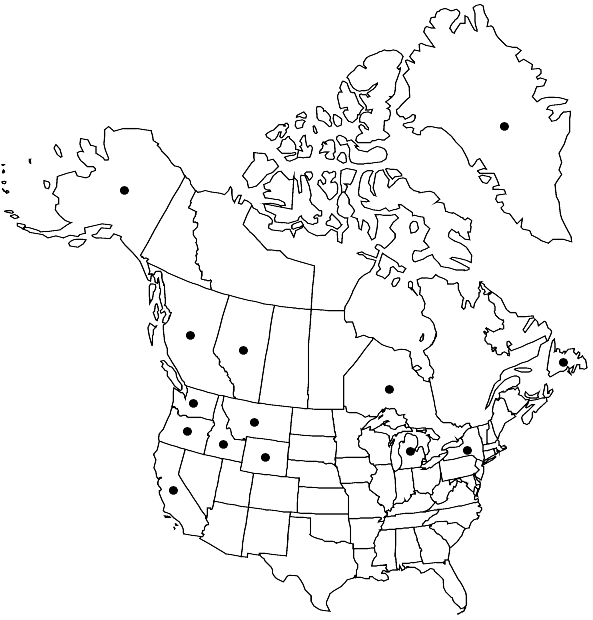Niphotrichum elongatum
in R. Ochyra et al., Cens. Cat. Polish Mosses, 138. 2003,.
Plants medium-sized to large, in large, dense or loose tufts or mats, grayish olive or olivaceous in the distal part, brown or grayish proximally. Stems (1–)3–10(–13) cm, creeping, decumbent to ± erect, mostly pinnately branched with short, tuft-like branchlets, usually distinctly recurved at the apex. Leaves imbricate, not altered on drying, recurved when moist, ovate-lanceolate to subtriangular, indistinctly plicate, 2–3.2 × 0.8–1.2 mm; margins broadly recurved throughout; apices sharply carinate, most often piliferous, awns recurved to reflexed, subulate, strongly denticulate, mostly long-decurrent, slightly to distinctly papillose distally, strongly papillose basally with high and narrow papillae; costa percurrent, situated at the base of a moderately deep, wide-angled channel and strongly flattened basaly, 75–100 µm wide; basal laminal cells long-rectangular, 20–50 × 4–6 µm, moderately thick-walled, nodulose, papillose with large papillae, except for 1–4 rows of epapillose cells at the insertion; alar cells hyaline, thin-walled in 3–5 rows, forming a sharply delimited, convex group; supra-alar cells short, thick- and sinuose-walled, forming non-transparent border of 6–10 cells; medial and distal laminal cells subquadrate to rectangular, 6–20 × 5–8 µm, distinctly papillose. Inner perichaetial leaves hyaline, piliferous. Seta brown, glistening, 10–15 mm. Capsule brown, long-cylindric, 1.4–1.8 mm, sulcate when dry; peristome teeth 650–800 µm long, reddish brown to red, split to the base into 2 filiform prongs, densely papillose. Spores 9–11 µm.
Habitat: Dry sandy and gravelly soil, outcrops, tracks and in quaries, dry subalpine meadows, non-calcareous substrates, occasionally limestone grasslands or on thin soil over limestone
Elevation: low to moderate elevations (0-1500 m)
Distribution

Greenland, Alta., B.C., Nfld. and Labr. (Nfld.), Ont., Alaska, Calif., Idaho, Mich., Mont., N.Y., Oreg., Wash., Wyo., Europe, Atlantic Islands (Iceland, Madeira).
Discussion
Niphotrichum elongatum has only recently been formally described as a distinct species. Although it was distinguished at that level by several bryologists of the early eighteenth century, it subsequently fell into oblivion and was merged with N. canescens. It is very distinct, though closely related to N. ericoides. In contrast to the latter, it is a more southern taxon, and in North America does not extend to the Arctic, reaching its northernmost locality on Gilbert Island in southeastern Alaska. Apart from a few collections from the southernmost tip of Greenland, it has been found only once at lat. 70º N in East Greenland. It grows in habitats similar to those of N. ericoides, with which it often occurs in mixed stands, but the latter generally favours drier, warmer, and more exposed microhabitats than the former.
Selected References
None.